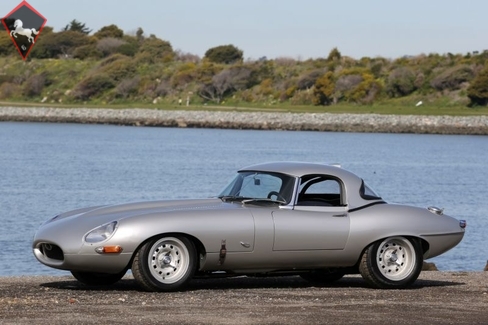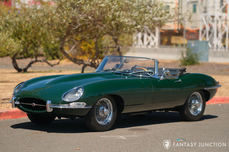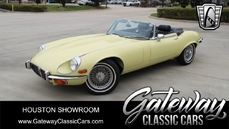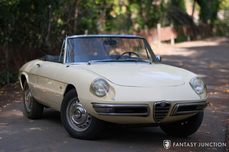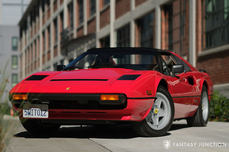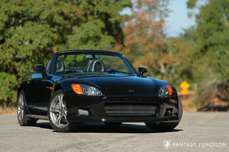Jaguar E-type 4.2 liter inline-6 no. 8L148468-S 1965
Allmän beskrivning :
1965 Jaguar E-Type Lightweight #11 Recreation
s/n 1E10022 engine no. 8L148468-S
Opalescent Silver with Black Interior
When Jaguar unveiled the E-Type at the 1961 Geneva Motor Show, everything in the sports car world was about to change. Stunning design, unrivaled performance, cutting edge technology, and racing lineage made the E-Type an immediate sensation. The beautiful lines and attractive pricing made the E-Type highly desirable for road use, but on the racetrack, Jaguar delivered again with top performance. Standard cars were raced regularly by privateers, but it was the factory lightweight cars that achieved the most renown. Comprehensively remanufactured in aluminum and fitted with race upgraded mechanical components from end to end, the E-Type Lightweight is now a legend. Aesthetically, the car was transformed as well: bumpers were removed, the rear fenders were expanded to accommodate purposeful Dunlop alloy wheels, and extractors were added to the hardtop and trunk lid. Just 12 examples were built and the cars remain among the most desirable Jaguar cars ever made.
While the lightweight resembles a standard E-Type, changes were substantial, and building an authentic recreation of one is extraordinarily involving. This no expense spared recreation is a testament to the dedication and enthusiasm of its builders and is a stunning tribute to the legendary E-Type Lightweight. Built to impeccable standards by top fabrication specialists over a eight year period, this car is closely patterned after the 11th Lightweight built, first registered 2GXO in London in 1963.
According to the Jaguar Heritage Trust Certificate, this car, chassis #1E10022 was produced in August 1964 and originally finished in cream with dark blue interior. This roadster came under long-term ownership in the 1980s until it was sold in 1995 to a Jaguar enthusiast who appreciated how straight and solid it was. Retaining its matching numbers engine, the car was at this time red, and its owner drove it for about three years, during which time he embarked on a personal quest to fastidiously research and document as many details as possible regarding the E-Type Lightweights. By 1998, he had reached the ultimate decision point and decided to embark on a build to recreate, as faithfully as possible, 2GXO.
He began by carefully disassembling the entire car, photographing and cataloging his efforts along the way. In 1999, Jaguar expert Steve Helms media blasted the entire shell and the metal work began. In April 2000, an order was placed with Dunford Limited, UK for all aluminum panels to be fabricated by master craftsmen. The order included two doors, a hardtop, a complete bonnet, boot lid, rear quarter panels, and boot/hardtop panel vents to replicate those of 2GXO. At this time Dunlop racing wheels, hubs and a variety of other specific Lightweight parts and pieces were purchased totaling nearly $20,000. Between 2003-2005, and additional $36,000.00 was spent with a local aluminum fabrication specialist to shape and contour the panels, fit them to the monocoque, and prep the car for paint. Jaguar monocoque experts Lindley Motors then completed the final paint prep, paint, and finishing for re-assembly. In September 2005, the body and frame was completed to show quality finish, ready for Steve Helms to re-assemble.
The details of the engine were recreated using the original specifications and period blue prints. The original engine was set aside and left undisturbed (and is included with the car), and a newer 4.2 liter XJ6 engine procured specifically because of its larger oil galleys and other updates, making it well suited to being built up to produce more power when compared to the original E-Type engine. E-Type race engine specialists Hyde Villa Machine Shop in Reading, PA were commissioned to build the engine. A few details of the extensive rebuild include a balancing and blue printing, porting and polishing, Venolia +.020 pistons, new rods, Isky race cams, aluminum fly wheel, 3 Weber DCOE 45 152 carburetors, AP clutch, stainless steel headers, and stainless steel exhaust. Only the finest components were utilized, making a performance engine that would readily and reliably perform safely on pump gas, but even better on racing fuel. A detailed specification sheet with parts totaling over $10,000.00 is included in the records with this car. Despite the competition-oriented build, the engine is impressive tractable and well-mannered. Additionally, with the original engine (included with the car) refitted, the car would be eligible for FIA European vintage racing.
Once the engine was completed, the suspension and braking system were tended to with the same attention to detail. Willwood brakes and Spax shocks were installed as well as upgraded suspension bushings, and stainless steel brake lines and adjustable torsion bar reaction plates. Further sorting continued to the exterior of the car installing a LeMans filler cap, finishing the extractor vents, correct roll bar, and other supporting details. The build was completed in 2006, with minor sorting and maintenance performed during the years since the car’s completion.
Today, the car presents as a spectacular authentic Lightweight with both impressive presence and excellent finishes throughout. The paint was done to a very high standard, with excellent gloss and consistent coverage throughout. There are some minor paint blemishes, including light scuffing under the nose, a ¼” paint blemish on the drivers side quarter panel, and a few minor chips that have been touched up. Panel fit and gaps are excellent in all aspects with proper rubber components tightly fitting and correctly finished aluminum trim strips in place of the bumpers. The lighting, lenses, and windshield are in excellent condition with exceptional attention to the leather bonnet and boot latches, properly trimmed exterior features, and of course the gorgeous staggered wheels and tires which contribute perfectly to the hunkered down racing profile of this fine recreation. Further in keeping with the competition build, the side and rear glass has been replaced with lighter weight lexan.
The interior of the car is as carefully thought out and detailed as the exterior. Opening the aluminum doors, one immediately feels the lightness as an invitation to the competition-inspired interior. Aluminum seats are wrapped in supple black leather accompanied by 4-point seat harnesses, exposed central tunnel, minimal carpeting, and beautifully riveted roof vent in the headliner. The look and feel is precise but vintage, with just enough comfort and elegance conveying a purposeful build that remains streetable. The leather wrapped steering wheel and beautifully finished black dashboard feature an array of E-Type instruments, which have all been rebuilt by Nisonger, including a rare 6,500 rpm tachometer, specific to Lightweight cars. The trunk is spartan, but is as nicely finished as the rest of the car with a black Ambla mat and spare wire wheel with tire.
Lifting the lightweight aluminum hood, the engine and exceptionally well-detailed engine bay reveals beautiful finishes and proper attention once again to the competition history in homage to the original. The view is dominated by the triple Weber carburetors, while further inspection reveals the beautifully finished aluminum radiator and header tank. A Coolcats electric fan is also fitted. The engine is very well conceived and built with proper features including proper cabin ducting, wiring, and other details, all of which are finished to very high standards. Further delightful features include polished cam covers, stainless exhaust, beautifully hued from use, and finely finished suspension. The underside of the car is very clean, nicely sorted, and remains nicely detailed throughout. The workmanship, fit, and finish are exemplary in the chassis and components, reflecting a cohesive and exceptional build.
Nestling inside the interior, turning the key energizes the electrical system and the fuel pump clicks, rapidly at first, and then slows as fuel pressure builds. Depressing the starter button ignites the twin cam engine, which is snappier and more aggressive than stock, but still tractable and streetable. Throttle response is excellent, and the engine has a balanced, smooth feeling. The exhaust sound and induction noises from the Webers are magnificent. The increased power and reduced weight provide explosive acceleration that represents a dramatic difference against a standard E-Type. The gearbox is a full synchro unit from 1965 and works very smoothly, with a slickness that is not usually present in these gearboxes. The leather rimmed steering wheel and larger wheels give a substantial feel to the steering that inspires the driver’s confidence and telegraphs the increased grip available from the wider front tires. The suspension provides more precise handling and reduced body movement but remains compliant and comfortable for street use. The overall driving experience is thrilling and evocative, but not so raw as to preclude comfortable street use. The noise level inside the car is suitable for touring, heat levels in the car are properly managed, and the controls, including the clutch, have a linear, progressive operation. A host of spares is included with the car along with the original engine, records supporting the fabrication, parts listing, and services performed on the car.
This exceptional Lightweight recreation represents the ideal blend of stunning presence, authentic aesthetics, and upgraded but still street-friendly performance. A fastidiously and enthusiastically built example that beautifully captures the essence of the ultimate E-Type, this car reflects the vision and dedication of its builder and the expert teams that built it.
http://fantasyjunction.com/cars/2090-Jaguar-E-Type%20Lightweight%20%20%20%20%20%20%20%20Replica-4.2%20liter%20inline-6
1965 Jaguar E-type 4.2 liter inline-6 no. 8L148468-S is listed såld on ClassicDigest in Emeryville by Fantasy Junction for $198500.
Fakta i bilen
Karosstyp : Personbil Märke : Jaguar Modell : E-type Modellversion : 4.2 liter inline-6 no. 8L148468-S Motorvolym : 4.2 Årsmodell : 1965 Läge : Emeryville
Såld
Information om säljaren
Såld
People who viewed this Jaguar E-type also viewed similar Jaguar listed at ClassicDigest
Other cars listed for sale by this dealer
om Jaguar
Åh, historien om Jaguar, från dess tidiga dagar som SS Cars Ltd. till sin höjdpunkt med D-typen och gatubilsevolutionen i form av den ikoniska E-typen. Det finns något alldeles brittiskt över denna berättelse, och jag ska berätta den som en brittisk journalist skulle göra.
I början:
Vår resa in i Jaguar-världen börjar på 1930-talet, när ett företag som kallades SS Cars Ltd. dök upp. Trots den olyckliga sammanträffandet av deras initialer med de stigande politiska spänningarna i Europa började de producera stilfulla och prestandainriktade bilar. SS 100, som introducerades 1936, var en symbol för elegans och hastighet och lade grunden för vad som skulle bli Jaguar.
Jaguars födelse:
När skuggan av andra världskriget närmade sig beslutade SS Cars Ltd. klokt att distansera sig från SS-initialerna. Så 1945 blev de officiellt Jaguar Cars Ltd., ett namn som snart skulle bli synonymt med brittisk lyx och prestanda.
XK-serien:
Jaguars efterkrigstid gav oss XK 120, en verklig sensation 1948. Med sin strömlinjeformade design och en kraftfull 3,4-liters raksexmoters blev den världens snabbaste seriebil. XK 120 var ritningen för det som komma skulle - Jaguar som förenade stil med hastighet på ett unikt brittiskt sätt.
D-typens dominans:
Sedan kom D-typen, en sann racinglegend. Introducerad 1954, vann den Le Mans tre gånger på 1950-talet och visade Jaguars tekniska skicklighet. Med sin innovativa monokokkonstruktion och den ikoniska fenan bak var D-typen höjdpunkten av Jaguars framgång inom motorsport.
E-typens framträdande:
Men den verkliga vändpunkten kom 1961 med introduktionen av E-typen, ofta beskriven av Enzo Ferrari som "den vackraste bilen som någonsin byggts". Dess långa motorhuv, böljande kaross och en 3,8-liters motor som levererade upphetsande prestanda gjorde den till en omedelbar klassiker. E-typen var inte bara en bil; den var ett konstverk på hjul och kunde nå 150 mph på vägen.
Gata och racingsuccé:
E-typens skönhet matchades av dess förmåga på racerbanan. De lätta E-typarna var särskilt framgångsrika i olika racingevenemang och cementerade Jaguars rykte som en kraft att räkna med inom motorsport.
Raffinemangets ålder:
När vi fördjupar oss i Jaguar-historien finner vi att 1950-talet och 1960-talet var en tid av raffinering och expansion. Tillsammans med den magnifika D-typen och den ikoniska E-typens framträdande introducerade Jaguar modeller som ytterligare befäste sitt rykte för lyx och prestanda.
MK2:
I slutet av 1950-talet presenterade Jaguar MK2, en sportig sedan som kombinerade elegans med kraft. Denna eleganta fyradörrars salong var en favorit bland bankrånare och polisen, tack vare dess exceptionella hastighet och hantering. MK2 var en symbol för Jaguars förmåga att förena sofistikering med prestanda och hade också en framgångsrik racingkarriär.
XJ6:
Hoppa fram till 1968 och Jaguar lanserade en bil som skulle definiera lyxbilar i decennier framöver - XJ6. Det var ett mästerverk i teknik och design med en jämn raksexmoters, oberoende bakre fjädring och en rymlig, vackert inredd interiör. XJ6 var en symbol för brittisk elegans och erbjöd en så smidig åktur att det kändes som om den gled över vägen. Den blev flaggskeppsmodellen för Jaguar och satte standarden för lyxbilar och visade en nivå av raffinering som imponerade på konkurrenterna.
Blandningen av klassiskt och modernt:
Medan MK2 och XJ6 representerade utvecklingen av Jaguars sedanmodeller, bibehöll de märkets engagemang för prestanda och lyx. Dessa bilar hörde inte bara hemma på racerbanan; de trivdes lika bra på de stora boulevarderna som på en avslappnad körning genom den engelska landsbygden.
Utmaningarna av förändring:
Men när 1970-talet närmade sig, ställdes Jaguar, liksom många brittiska biltillverkare, inför ekonomiska utmaningar och ägarförändringar. British Leyland-eran förde både möjligheter och svårigheter med sig när varumärket navigerade genom olika sammanslagningar och övergångar.
Ändå fortsätter arvet från MK2 och XJ6, tillsammans med D-typen och E-typen, att definiera Jaguar som en tillverkare som förenar tidlös elegans med en anda av prestanda. Dessa klassiska modeller, vare sig de körs på slingrande vägar eller står som samlarföremål, tjänar som ett vittnesbörd om Jaguars långvariga närvaro inom den automobila exklens värld.
Jaguar-historien, från dess tidiga dagar som SS Cars Ltd. till skapandet av ikoner som E-typen, MK2 och XJ6, är en resa som speglar essensen av brittisk bilkultur - en blandning av lyx, kraft och stil som fortsätter att fängsla entusiaster och samlare över hela världen.
